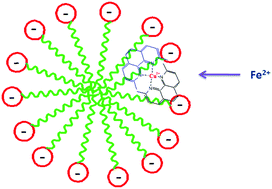当前位置:
X-MOL 学术
›
New J. Chem.
›
论文详情
Our official English website, www.x-mol.net, welcomes your
feedback! (Note: you will need to create a separate account there.)
Self-assembled nanocontainer mediated oxidation of Fe(ii) by Cu(ii)–neocuproine complex: a model system to emulate electron transfer proteins†
New Journal of Chemistry ( IF 2.7 ) Pub Date : 2018-03-19 00:00:00 , DOI: 10.1039/c8nj00998h Parvaiz Ahmad Bhat 1, 2, 3, 4, 5 , Oyais Ahmad Chat 1, 2, 3, 4, 5 , Aijaz Ahmad Dar 1, 2, 3, 4, 5
New Journal of Chemistry ( IF 2.7 ) Pub Date : 2018-03-19 00:00:00 , DOI: 10.1039/c8nj00998h Parvaiz Ahmad Bhat 1, 2, 3, 4, 5 , Oyais Ahmad Chat 1, 2, 3, 4, 5 , Aijaz Ahmad Dar 1, 2, 3, 4, 5
Affiliation

|
An otherwise thermodynamically unfavourable oxidation of iron(II) by copper(II) facilitated by complexation of the oxidant with neocuproine was studied in micelle-based nano-containers of varying architecture. Pseudophase and Berezin's kinetic models were respectively used to understand the underlying mechanism of the reaction in the microheterogeneous environs of cationic/nonionic and anionic/mixed surfactant systems. The results highlight the importance of hydrophobic and electrostatic forces in modifying the kinetics of redox reactions, having relevance in understanding the behaviour of electron transfer proteins in actual biological systems.
中文翻译:

自组装的纳米容器介导的Cu(ii)-新古铜络合物对Fe(ii)的氧化:模拟电子转移蛋白的模型系统†
在不同结构的基于胶束的纳米容器中,研究了通过氧化剂与新环丙氨酸的络合促进了铜(II)在其他方面在热力学上不利于铁(II)的氧化。伪相动力学模型和Berezin动力学模型分别用于了解阳离子/非离子和阴离子/混合表面活性剂体系在微非均相环境中反应的潜在机理。结果突出了疏水力和静电力在修饰氧化还原反应动力学方面的重要性,与理解实际生物系统中电子转移蛋白的行为有关。
更新日期:2018-03-19
中文翻译:

自组装的纳米容器介导的Cu(ii)-新古铜络合物对Fe(ii)的氧化:模拟电子转移蛋白的模型系统†
在不同结构的基于胶束的纳米容器中,研究了通过氧化剂与新环丙氨酸的络合促进了铜(II)在其他方面在热力学上不利于铁(II)的氧化。伪相动力学模型和Berezin动力学模型分别用于了解阳离子/非离子和阴离子/混合表面活性剂体系在微非均相环境中反应的潜在机理。结果突出了疏水力和静电力在修饰氧化还原反应动力学方面的重要性,与理解实际生物系统中电子转移蛋白的行为有关。











































 京公网安备 11010802027423号
京公网安备 11010802027423号